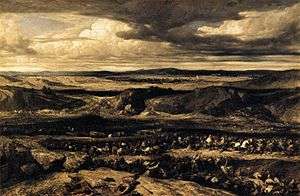Battle of Vercellae
| Battle of Vercellae | |||||||
|---|---|---|---|---|---|---|---|
| Part of the Cimbrian War | |||||||
 Giovanni Battista Tiepolo, The battle of Vercellae, 1725-1729 | |||||||
| |||||||
| Belligerents | |||||||
|
| Cimbri | ||||||
| Commanders and leaders | |||||||
|
Gaius Marius, Quintus Lutatius Catulus |
Boiorix † Lugius † Claodicus (POW) Caesorix (POW) | ||||||
| Strength | |||||||
| 50,000 men (8 legions with cavalry and auxiliaries) | about 210,000 | ||||||
| Casualties and losses | |||||||
| about 1,000 killed |
about 140,000 killed, 60,000 captured | ||||||

The Battle of Vercellae, or Battle of the Raudine Plain, in 101 BC was the Roman victory of Consul Gaius Marius over the invading Celto-Germanic [1][2] tribe of the Cimbri near the settlement of Vercellae in Cisalpine Gaul.
Much credit for this victory has been given to the actions of Proconsul Quintus Lutatius Catulus's legate, Lucius Cornelius Sulla who led the Roman and allied Italian cavalry. The Cimbri were virtually wiped out, with the Romans claiming to have killed 140,000 and captured 60,000, including large numbers of women and children. Some of the surviving captives are reported to have been among the rebelling slaves in the Third Servile War.[3]
Location
Traditionally most historians locate the settlement of the battle in or near the modern Vercelli, Piedmont, in northern Italy. Some historians[4] think that "vercellae" is not a proper name and may refer to any mining area at the confluence of two rivers.
These historians think that the Cimbri followed the river Adige after having crossed the Brenner Pass, instead of "unreasonably" turning west to the modern Vercelli; this way, the location of the battle would be in the modern Polesine instead, possibly near the modern Rovigo. At Borgo Vercelli, near the river Sesia, 5 km from Vercelli, items have been found that supposedly strengthen the tradition.
Another suggested location is the hamlet of Roddi, in what is now the province of Cuneo, Piedmont.[5]
The battle
The 13,000 strong Cimbric cavalry rode onto the battlefield. Behind them came the 197,000 strong infantry. According to Plutarch, Marius made a final sacrifice to the gods.
"Marius washed his hands, and lifting them up to heaven, vowed to make a sacrifice of 100 beasts should victory be his".
The Romans got into position first, therefore the sun would be reflecting off the Roman's armor. The Cimbri thought the sky was on fire. Sensing their sudden anxiety, the Romans attacked. The Cimbri cavalry were taken completely by surprise by the Roman cavalry. The Cimbri were forced back. The Roman legionaries then engaged the Cimbri infantry. The Cimbri were very unnerved by this. Plutarch writes that the Romans now were able to slaughter the enemy with ease. Boiorix and his noblemen made a last stand in which they were all killed. The Romans had won a complete and stunning victory.
Aftermath

The victory of Vercellae, following close on the heels of Marius' destruction of the Teutones at the Battle of Aquae Sextiae the previous year, put an end to Germanic plans to invade Rome. The Cimbri were virtually wiped out, with the Romans claiming to have killed 140,000 and captured 60,000, including large numbers of women and children. Children of the surviving captives may have been among the rebelling gladiators in the Third Servile War.[6]
Politically, this battle had great implications for Rome as well. It marked a continuation in the rivalry between Marius and Sulla, which would eventually lead to the first of Rome's great civil wars. As a reward for their gallant service, Marius granted Roman citizenship to his Italian allied soldiers, without consulting or asking permission from the Senate first. When some senators questioned this action, he would claim that in the heat of battle he could not distinguish the voice of Roman from ally from the voice of the law. Henceforth all Italian legions would be Roman legions. This was also the first time a victorious general had openly defied the Senate and it would not be the last; in 88 BC, Sulla, in defiance of both the Senate and tradition, would lead his troops into the city of Rome itself. And Julius Caesar, when ordered by the Senate to lay down his command and return to Rome to face misconduct charges, would instead lead one of his legions across the Rubicon in 49 BC. This would mark the start of the civil war between himself and senatorial forces under Pompey which would effectively end the Roman Republic.
See also
References
- ↑ "A Dictionary of Arts, Sciences, Literature and General Information". The Encyclopædia Britannica. 5–6 (11 ed.). Pennsylvania State University: The University Press. 1911.
- ↑ Dawson, Edward. "Cimbri & Teutones". The History Files. Kessler Associates. Retrieved 18 May 2016.
- ↑ Strauss, Barry (2009). The Spartacus War. Simon and Schuster. pp. 21–22. ISBN 1-4165-3205-6.
- ↑ for instance: Zennari, Jacopo (1958). La battaglia dei Vercelli o dei Campi Raudii (101 a. C.) (in Italian). Cremona: Athenaeum cremonense.
- ↑ Descriptive material in the Ethnological Museum of the Castle of Grinzane Cavour.
- ↑ Barry Strauss, The Spartacus War, p. 21
- Sources
- Mommsen, Theodor, History of Rome, Book IV "The Revolution", pp 71–72.
- Florus, Epitome rerum Romanarum, III, IV, partim
- Todd, Malcolm, The Barbarians: Goths, Franks and Vandals, pp 121–122.